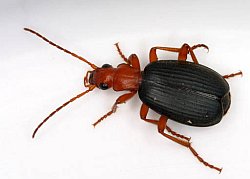Full title: What really counts – changes in ground beetle assemblages on the Keuperscharren in the Luxembourg and Bitburger Gutland since the nineteen-eighties
Abstract
 Twentieth century anthropogenic global change has already affected all of the earth biota. One-third to one half of earth’s ice free surface has been transformed by human land use. This land cover change represents the most important component of global change now, and will do so for the next decades to come.
Twentieth century anthropogenic global change has already affected all of the earth biota. One-third to one half of earth’s ice free surface has been transformed by human land use. This land cover change represents the most important component of global change now, and will do so for the next decades to come.
Especially for semi-natural grasslands in Central- Europe intensification or abandonment has resulted in a dramatic reduction of such habitats. The Keuperscharren in the Bitburger and Luxembourger Gutland present examples for the threat through abandonment. Because they are rated as historical dry grasslands (cultural-historical meaning), the Scharren in the Bitburger Gutland are protected by the Habitat Directive. This implies a prohibition of degradation for those sites.
To satisfy this claim, a fundamental knowledge of factors, influencing this habitat is vital. Carabid beetles can be used very well as indicator species to determine the stability or changes in habitats. Therefore, in this study, the factors determining stability or changes on the Keuperscharren should be defined, based on a habitat suitability model and autecological studies for the representative carabid species. Based on a microsatellite analysis, the effect of habitat fragmentation on the genetic interchange between the different sites and potential genetic depletion will be measured. Based on that knowledge, propositions for a customized management for such sites can be made. This will contribute vital information to fulfil the requirements of protecting those Keuperscharren as places with a cultural – historical meaning. Furthermore this study will provide valuable data for the endeavour to compile a Red List on the Ground beetles in Luxembourg or a Red List of the Rhine-Province.
Status of PhD
Supervisor at university: Prof. Dr. Roland Klein , FB VI Geography, faculty of biogeography, university of Trier.
Supervisor in Luxembourg: Marc Meyer, Musée National d´histoire naturelle Luxembourg.
PhD granted by Fonds national de la recherche Luxembourg. Duration: 3 years (01.09.2009 – 31.08.2012).
Host institution: Fondation faune-flore @ Centre de recherche scientifique, Musée national d’histoire naturelle.
Contact
Dipl. Biogeogr. Bettina Augenstein
Musée national d’histoire naturelle
Centre de recherche scientifique
Laboratoire/Section Zoologie des invertébrés
24, rue Münster
L-2160 Luxembourg
bettina.augenstein@mnhn.lu
Publications and not published works
- Augenstein B (2007) Laufkäferzöbnosen in Weinbergsbrachen als Nahrungsgrundlage für das Große Mausohr. Dipl. Thesis. (pages? University?)
- Habel JC, Augenstein B, Nève G, Rödder D (2010) Population genetics and ecological niche modelling reveal high fragmentation and potential future extinction of the endangered relict butterfly Lycaena helle. In: Habel JC, Assmann T (Eds.) (2010) Relict Species. Phylogeography and Conservation Biology. XV, 449 p. ISBN: 978-3-540-92159-2.
- Schmitt T, Augenstein B, Finger A (2008) The influence of viniculture and its fallow stages on the butterfly diversity in a wine growing region of southwestern Germany. European Journal of Entomology 105: 249-255.
Talks and poster presentations
- Augenstein B (?) Laufkäferzönosen auf Weinbergslagen als Nahrungsgrundlage für Myotis myotis. Talk, annual meeting, Landesfachausschuss Fledermausschutz. (Where?)
- Augenstein B (?) Anwendung und Funktionsweise von Ökologischen Nischenmodellen. Talk, annual meeting, Gesellschaft für Angewandte Carabidologie. (Where?)